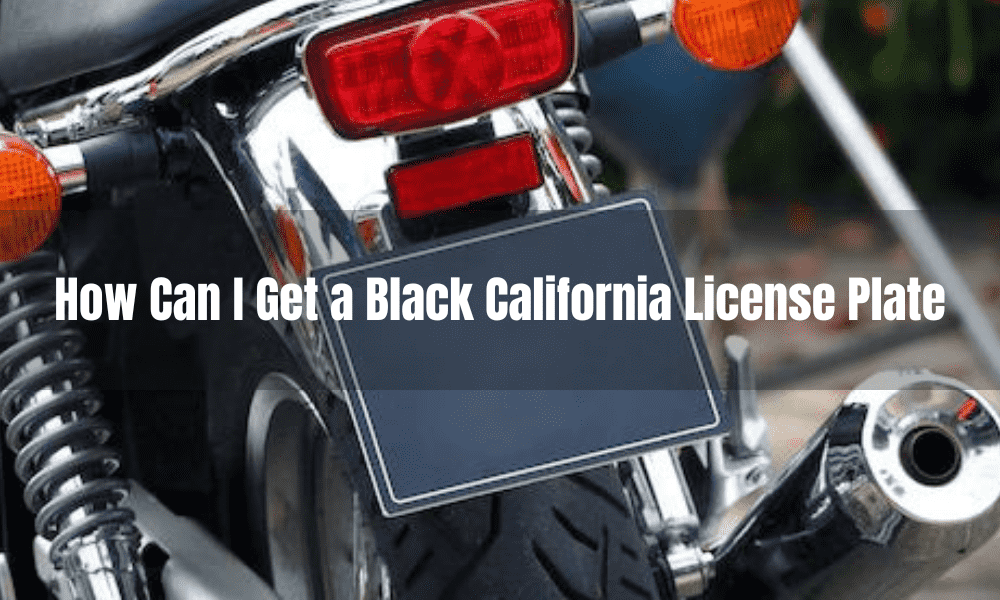How Can I Get a Black California License Plate
A California license plate is a state-issued identification for your vehicle. It is legally required to have a license plate on your vehicle in order to drive on California roads. The California Department of Motor Vehicles (DMV) is responsible for issuing and renewing license plates.
There are several California license plates available, including standard, personalized, and special interest plates. Standard plates are the traditional blue and yellow plates with the state’s name and a unique number assigned by the DMV. Personalized plates allow you to choose a custom combination of letters and numbers to display on your plate. Special interest plates include options like vanity plates, organizational plates, and military plates.
To obtain a California license plate, you will need to register your vehicle with the DMV and provide proof of ownership. You will also need to pay any required fees, such as registration fees or personalized plate fees. Once your vehicle is registered, the DMV will mail your license plate to you or you can pick it up at the DMV office.
It is important to note that California has different regulations for different types of vehicles, for example, electric vehicles have special license plates.
It’s also important to note that California license plates need to be renewed on a regular basis, usually annually, and a sticker will be provided to put on the plate as proof of renewal.
01. Research the eligibility requirements
When considering getting a black California license plate, it’s important to research the eligibility requirements first. The California Department of Motor Vehicles (DMV) has specific guidelines on which vehicles are eligible to have a black license plate. Not all vehicle types are eligible for black plates.
The DMV website is a great place to start researching eligibility requirements. You can find information on which vehicles are eligible, as well as any additional fees that may be required. The website can also provide information on the application process and any documentation you will need to submit.
It is also important to note that black license plates are only available for certain types of vehicles and are only available for a limited time, so it’s best to act quickly if you’re interested in obtaining one. Additionally, you may be required to pay additional fees for a black license plate.
Aside from the DMV website, you can also reach out to the local DMV office and speak to a representative who can provide you with more information on the eligibility requirements for black license plates. They can also answer any questions you may have about the application process.
It’s crucial to research the eligibility requirements before applying for a black license plate, as it will save you time and money in the long run. By making sure that you meet the requirements and that you have all the necessary documentation, you can ensure a smooth and efficient process.
02. Gather necessary documentation
Gathering the necessary documentation is an important step when applying for a black California license plate. The California Department of Motor Vehicles (DMV) requires certain documents to be submitted with your application in order to verify your eligibility and process your request.
The main document required to apply for a black license plate is proof of ownership of your vehicle. This can include the vehicle registration or title. Make sure the registration and title are up to date and in your name.
Additionally, you may be required to submit other documents such as a smog check certificate, proof of insurance, and a valid driver’s license. Make sure to check with the DMV website or reach out to the local DMV office to find out what documents are needed for your specific case.
It is also important to note that you may be required to pay additional fees for a black license plate, and you should have this information ready when you submit your application.
It’s a good idea to gather all the necessary documents and fees before applying to avoid delays or rejection of your application. Double-check the documents and ensure they are in order and up-to-date, this will increase your chances of getting the black license plate without any issues.
It’s also helpful to make copies of all the documents before submitting them, in case you need them in the future.
03. Obtain a smog check
Obtaining a smog check is a necessary step when applying for a black California license plate. A smog check is an emissions test that measures the level of pollutants emitted by your vehicle. The California Department of Motor Vehicles (DMV) requires certain vehicles to pass a smog check before they can be registered or renewed.
To obtain a smog check, you will need to visit a smog check station that is certified by the California Bureau of Automotive Repair (BAR). You can find a list of certified smog check stations on the BAR website or by searching for “smog check stations near me”.
During the smog check, the technician will perform a series of tests on your vehicle to measure the emissions. If your vehicle passes the test, you will receive a smog check certificate that you can use to register your vehicle. If your vehicle does not pass the test, the technician will provide you with a list of repairs that need to be made in order to pass the test.
It’s important to note that certain vehicles are exempt from the smog check requirement, including electric vehicles, hybrid vehicles, and vehicles that are six or fewer model years old. However, it’s always best to check with the DMV website or your local DMV office to be sure of the requirements for your vehicle.
It’s a good idea to schedule a smog check well in advance of your registration renewal date to avoid any delays in getting your black license plate. It’s also a good idea to keep the smog check certificate in a safe place, as you may need to submit it to the DMV when you renew your registration in the future.
04. Fill out the application
Filling out the application is an important step when applying for a black California license plate. The application process can vary depending on the type of vehicle you own and where you live, so it’s important to check with the California Department of Motor Vehicles (DMV) website or your local DMV office to find out what the specific requirements are for your situation.
Generally, you will need to fill out an application form and submit it to the DMV along with any required fees and supporting documentation, such as proof of ownership and a smog check certificate. The application form can typically be found on the DMV website and can also be obtained at a local DMV office.
When filling out the application, make sure to provide accurate and complete information. This includes your personal information, vehicle information, and any other relevant details. Double-check the application for any errors or missing information before submitting it.
It’s also important to pay close attention to the instructions on the application form and to submit it along with all required fees and documents. Failure to do so can result in delays or rejection of your application.
Once the DMV has received and processed your application, they will mail your black license plate to you or you may be able to pick it up at the DMV office. It’s important to keep in mind that the processing time can vary and it’s always best to check with the DMV website or your local DMV office for an estimate of the processing time.
05. Submit the application
After researching the eligibility requirements and ensuring that the vehicle meets the criteria, the next step in the process of getting a black California license plate is to submit the application.
The application can be obtained from the California Department of Motor Vehicles (DMV) or it can be downloaded from their website. The application typically requires information about the vehicle, including the make, model, and year, as well as the vehicle identification number (VIN). It also requires information about the owner, such as their name and address.
Along with the application, you will also need proof of ownership, such as a current registration or title. If the vehicle is not registered in California, you may need to provide additional documentation, such as a bill of sale.
You will also need to pay a fee to submit the application. The fee will vary depending on the type of license plate you are applying for and the length of time the plates will be valid. The fee is non-refundable even if the application is denied.
It’s important to submit the application along with all the required documents, and the fee, to the DMV as soon as possible to avoid any delay in the process. It’s also a good idea to keep a copy of the application and all the documents for your records.
After the application is submitted, the DMV will review it and determine whether the vehicle meets the criteria for a black California license plate. If the application is approved, the DMV will issue the plate and mail it to the owner.
07. Pay the fees
Obtaining a black California license plate requires paying certain fees set by the California Department of Motor Vehicles (DMV). These fees are intended to cover the cost of issuing and maintaining the license plate and are necessary to complete the process of getting a black California license plate.
The first fee that must be paid is the application fee. This fee is required to submit the application and varies depending on the type of license plate you are applying for and the length of time the plates will be valid.
Another fee that must be paid is the renewal fee. Black California license plates must be renewed every year and the renewal fee is typically due at the same time as the vehicle registration. The renewal fee may be different from the initial application fee.
Additionally, there may be additional fees for personalized license plates or other services such as a new registration card or a new sticker.
It’s important to be aware of all the fees that will be required when applying for a black California license plate and budget accordingly. It’s also important to note that these fees are non-refundable even if the application is denied.
It’s always a good idea to check with the California DMV for the most up-to-date information on the fees. The DMV website or a local office can provide more detailed information on the costs associated with obtaining a black California license plate.
08. Wait for approval
After submitting the application, providing all the required documents, and paying the fees for a black California license plate, the next step is to wait for approval from the California Department of Motor Vehicles (DMV).
The approval process typically takes a few weeks but can vary depending on the workload of the DMV and the completeness of the application. The DMV will review the application to ensure that the vehicle meets the criteria for a black California license plate, such as being at least 30 years old and being used for historical or collector purposes.
It’s important to be patient while waiting for approval as the process may take longer than expected. If there is any missing information or incorrect documentation in the application, the DMV may request additional information and it may delay the approval process.
If the application is approved, the DMV will issue the black California license plate and mail it to the owner. The owner will also receive a registration card and a sticker to place on the license plate.
If the application is denied, the DMV will notify the owner in writing and explain the reason for the denial. The owner may appeal the decision or reapply for a black California license plate after correcting the issue.
During the waiting period, it’s important to check the status of the application and be prepared to provide additional information if requested by the DMV.
09. Receive your plate
Once the application for a black California license plate is approved by the California Department of Motor Vehicles (DMV), the final step is to receive the plate. The DMV will issue the black California license plate and mail it to the owner.
The owner can expect to receive the plate in the mail within a few weeks of the approval. Along with the plate, the owner will also receive a registration card and a sticker to place on the license plate. The registration card serves as proof that the vehicle is registered and the sticker shows the expiration date of the registration.
It’s important to check the plate and the documents carefully upon receiving them to make sure that they are in good condition and that the information is correct. If there are any issues, it’s important to contact the DMV as soon as possible to get them resolved.
Once the plate is received, it’s important to install it on the vehicle according to the DMV guidelines and regulations. The owner should also update the registration card with the new plate number and ensure that the sticker is placed on the plate.
Having a black California license plate can be a way to show pride in the state or add a unique touch to the vehicle. It’s important to follow all the DMV guidelines, pays the fees, and renew the plate every year to keep the plate in a valid status.
10. Install the plate
After receiving the black California license plate, the next step is to install it on the vehicle. The process of installing the plate is relatively simple, but it’s important to follow the guidelines set by the California Department of Motor Vehicles (DMV) to ensure that the plate is installed correctly.
The first step is to remove the old license plate from the vehicle. This typically involves removing the screws or bolts that hold the plate in place. Once the old plate is removed, the new black California license plate can be installed.
The new plate should be mounted in the same location as the old plate, typically on the front and rear of the vehicle. The plate should be level and not tilted. It is important to make sure that the plate number is visible and not obstructed by any other object or part of the vehicle.
The next step is to secure the plate in place. This typically involves using screws or bolts to attach the plate to the vehicle. It’s important to use the correct hardware and not overtighten the screws or bolts, as this can damage the plate or the vehicle.
Once the plate is installed, the owner should update the registration card with the new plate number, and ensure that the sticker is placed on the plate. This sticker shows the expiration date of the registration.
It’s important to follow the DMV guidelines and regulations when installing the plate to avoid fines or penalties. It’s also important to check the plate and the documents regularly to make sure that they are in good condition and that the information is correct.
11. Register the plate
After installing the black California license plate, the final step is to register it with the California Department of Motor Vehicles (DMV). Registering the plate ensures that it is valid and that the vehicle it is attached to is in compliance with state laws.
The registration process typically involves updating the registration card with the new plate number and paying any necessary fees. The registration card serves as proof that the vehicle is registered and the new plate number should match the number on the card.
The owner will also need to renew the registration every year, and the renewal fee is typically due at the same time as the vehicle registration. The owner will also have to pay the renewal fee for the black California license plate.
It’s important to keep the registration card and the license plate in the vehicle at all times and to renew the registration on time to avoid any fines or penalties.
In addition to updating the registration card, the owner should also ensure that the sticker showing the expiration date of the registration is placed on the plate. This sticker must be visible and not obstructed by any other object or part of the vehicle.
It’s also a good idea to check with the California DMV for the most up-to-date information on the registration process and requirements. The DMV website or a local office can provide more detailed information on how to register a black California license plate.
FAQ:-
01. Can you legally change the color of your license plate in California?
Answer: No, in California, it is not legal to change the color of your license plate.
02. What color plates can you get in California?
Answer: In California, license plates are typically issued in white or yellow with black or blue lettering. These are standard license plate colors issued by the California Department of Motor Vehicles (DMV) and are the only legal color options.
Conclusion
obtaining a black California license plate is a process that involves researching the eligibility requirements, submitting an application, providing required documents, paying the fees, waiting for approval, receiving the plate, installing it, and finally registering it. The California Department of Motor Vehicles (DMV) issues these plates to vehicles that are at least 30 years old, used for historical or collector purposes, and have passed a smog check. It’s important to follow the DMV guidelines, pays the fees, and renew the plate every year to keep the plate in a valid status. Additionally, it’s important to note that changing the color of the license plate is not legal in California, the only legal color options are white or yellow with black or blue lettering.







